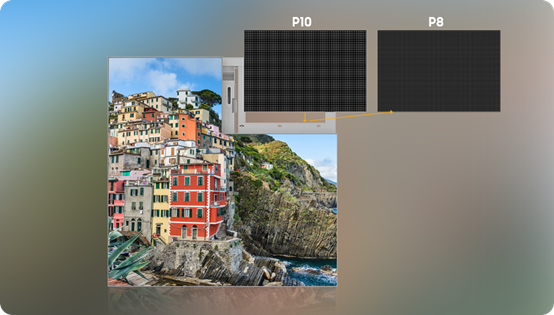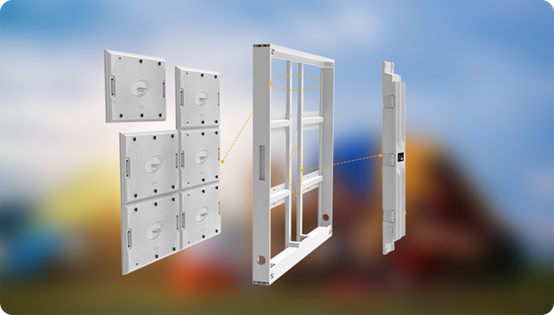Do you know how big the display you should choose? Or, sorry for the warning tone, what happen if you choose the wrong one? Then this guide will do good to you.
The shape of your LED screen (its aspect ratio) affects how your content fits on the screen, how it's framed, and even how people feel about what they're watching.
Different shapes can make you feel more involved, or they can help you focus on specific things. Choosing the right shape makes sure your message comes across clearly, without anything looking stretched or squished.
Let's look at the most common screen shapes you'll find:
Historically, the 4:3 aspect ratio was the standard for older television screens, computer monitors, and classic films. While less common for new productions, it remains relevant for specific applications, especially when dealing with legacy content or certain visual aesthetics.
The 4:3 ratio is well-suited for displaying "normal" videos, still pictures, and high-resolution photography that were originally produced in this format. It provides a more square, traditional viewing area.
The square screens, such as 4m x 3m LED displays, are often seen in venues like churches or auditoriums where older content or a more classic presentation style is preferred. This ratio is also beneficial when the primary content is static imagery or presentations not designed for widescreen viewing.
The 16:9 aspect ratio has emerged as the modern standard for high-definition content, encompassing everything from contemporary televisions and monitors to the vast majority of video productions and streaming services.
This widescreen format provides a panoramic view. It is the most commonly used ratio for LED display screens today. The ratio is ideal for videos, live broadcasts, and cinematic experiences, offering an immersive feel that aligns with modern content consumption habits. Most presentations, marketing videos, and event footage are now produced in 16:9.
If your goal is to showcase dynamic, high-definition video content, a 16:9 LED display screen is typically your best choice. Studies have proved that the expansive visual real estate that audiences expect from a cutting-edge LED video wall.
Here are the crucial factors to weigh when determining the ideal LED screen dimensions for your specific needs:
This is arguably the most critical factor. What type of content will you be displaying? If your presentations, videos, or graphics are primarily produced in a 16:9 widescreen format, then an LED video wall with a 16:9 aspect ratio will ensure great playback without distortion or letterboxing (black bars on the sides or top/bottom).
However, if you have a significant amount of older 4:3 content, or if your primary visuals are still images that fit a squarer format, a 4:3 display might be more appropriate to avoid cropping or stretching. Always align your display's aspect ratio with your content's native format for the best visual quality.
|
Event Type |
Preferred Aspect Ratio |
Application Details |
Editor’s Pick |
|
Conferences & Corporate Meetings |
16:9 |
Ideal for presentations and video playback; supports modern widescreen formats. |
|
|
Live Concerts & Entertainment |
16:9 or Custom |
Creates immersive, cinematic visuals; custom ratios used for artistic or stage design. |
LEX II (naked 3D Available) |
|
Trade Shows & Exhibitions |
4:3 or 16:9 |
4:3 for static displays; 16:9 for dynamic video content—depends on booth layout. |
|
|
Church |
4:3 |
Common for lyrics, announcements, and traditional religious imagery. |
While not directly an aspect ratio factor, viewing distance significantly impacts the perceived quality of your LED video wall.
A higher pixel pitch (larger distance between pixels) is acceptable for longer viewing distances, while shorter distances require a finer pixel pitch for clarity. The chosen aspect ratio then determines the overall dimensions and, in turn, the total number of pixels available for that specific screen size, influencing sharpness and detail at various distances.

The physical space available for your LED display screen sizes is a practical constraint. Measure the height and width of your designated installation area carefully.
An overly wide 16:9 screen might not fit a narrow space, just as a tall 4:3 screen might hit a low ceiling. Furthermore, consider your audience capacity and sightlines. A wider screen (like 16:9) might offer better visibility for a broader audience spread horizontally, while a more traditional 4:3 might be sufficient for a narrower, deeper audience seating arrangement.

Both indoor and outdoor LED video wall solutions are available in various aspect ratios. However, outdoor displays typically need to be brighter and more robust to withstand weather conditions.
The environment might influence the practical LED screen dimensions you can deploy. For instance, a very large 16:9 outdoor screen might require significant structural support, whereas an indoor setup might have different weight and mounting considerations.
If your event requires a temporary setup or you plan to frequently move the display, portability is key.
Modular LED display screen sizes allow for flexible configurations, enabling you to build screens with various aspect ratios on demand. For rental setups, standard aspect ratios like 16:9 are often preferred because they accommodate the most common content formats, making the panels versatile for different clients and events.

Ready to find the perfect LED display solution for your upcoming event?
Contact us down below today to explore their innovative range of indoor and outdoor LED display solutions tailored to every need.
I consent to receive emails about news, marketing&product updates from Retop in accordance with the Retop Privacy Policy